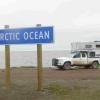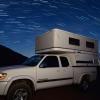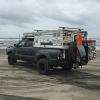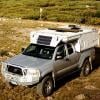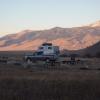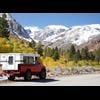Terrapin and some others have posted about electrical problems with their refrigerators (http://www.wanderthe...trical-sleuths/). I added some comments, but I also did not find much on WtW about how to pick solar panel wattage and battery amp hours, so I hope the following information is helpful.
To know what you need for a solar panel and batteries, you need to do some calculations based on where, when, and how long you camp off the grid.
First, estimate the maximum current (amps, A) that you will use in 24 hours for all of your electrical devices.
The compressor refrigerator is usually spec’ed in watts/day. Divide it by 12V (voltage). For example, if the refrigerator is spec’ed at 480 watts/day (W/day), then you will use, on average, 40Ah (amp hours) over one day. This assumes that the interior of your camper is at a comfortable temperature of somewhere around 68’F. Power consumption will be higher on hot summer days and less on cold winter nights. The interior of your camper will also increase or decrease your power use. Insulation and a fan over the condenser coils will help reduce power draw. Call it 40Ah per day for good measure – but if the refrigerator is well vented, if you have a fan to cool the coils whenever the compressor is on, if you are careful about minimizing door open time, and if it is reasonably well insulated, call it 30Ah per day.
The next biggest item is your heater fan. I think the heater fan FWC is now installing draws about 2A. If you run the heater 4 hours a day, that’s 8Ah per day. Obviously, when it’s cold, you run the heater more and the refrigerator less. Vice-versa when it’s hot.
Interior LED lighting consumes no more than 0.5A and is on, say for 4 hours. That’s 2Ah per day.
Cell phone and tablet charging consume about 3A per charge per device – so 6Ah per day for you and your partner.
If you run a laptop for an hour, add another 5Ah per day.
As you can see, the compressor refrigerator is the elephant in the camper. If you have the 3-way refrigerator, you don’t have an elephant. Just NEVER leave the 3-Way on DC without the engine running or being on shore power – that’s something like 5A or 120Ah per day (that’s a herd of elephants).
If you are really off the grid, you probably don’t have cell service, if what you read is on paper instead of a screen, if no computer, and if you are careful with the refrigerator, you can probably get by on 35Ah to 40Ah per day.
The next step is to size the batteries.
The number of draw down (discharge) cycles and the depth of the draw down determines battery life. The more cycles and the deeper the draw down, the shorter the battery life.
As battery life decreases, it provides less power – essentially, it’s Ah rating decreases. A general rule of thumb is to draw down your battery no more than 30%. This is typically the sweet spot for the most power at the least cost. You can expect about 80% of capacity after about 3 or 4 years.
At 40Ah/day you want about a 125Ah battery system to get you through one day. But that’s a new battery, So start with a 155Ah battery system and 3 or 4 years later, it should still be able to provide about 125Ah/day.
But wait… you have a 160w solar panel to put power back into the battery! Just how much power is, literally, all over the map. See the following link for North America: https://en.wikipedia...-America-en.png
Between Portland OR and San Diego CA, the available annual power from the sun varies by a factor of two. If only rain could also produce electricity, we’d be so much better off in Portland.
To get more specific, go to the following link and scroll down two pages to the interactive graph. Since the FWC solar panels are flat on the roof, choose 60’ for Tilt Angle. Now move the Latitude slider to the latitude where you will be camping off the grid and then read the vertical scale number for the time of year for the green line. In Portland (45’ N) on January 1 (day 1), the annual average power from the sun is 4.0 kWh/m2/day. On July 1 (day 183), it is 9.0 kWh/m2/day. For a rough estimate of the power supplied by your 160w panel, multiply the kWh/m2/day by 150. For my Portland example, that’s 600Wh and 1350Wh per day, on average on Jan 1 and July 1, respectively. The factor of 150 takes into account the size (m2) of the 160W panel, it’s conversion efficiency (18%), charge controller and other sytem losses (5% to 15%) and conversion from kWh to Wh. Dividing the panel output, Wh, by 12V gives us Ah/day. That’s 50Ah/day and 113Ah/day, respectively.
The result: for your FWC camper with a compressor refrigerator, you want at least a 160W panel and a 155Ah battery system since some days, especially in northern latitudes, will be so overcast that your panel output will be negligible. You may well get a week of grey skies. Of course, as soon as you move your campsite, you truck alternator will start to recharge the battery. Figure on 10A/hour or more from the truck. Back on shore power? No worries at all.
One more comment. FWC installs Exide marine batteries – these are not true deep cycle batteries. They are a compromise between a starting battery and a deep cycle battery. Because the plates are thinner, they can supply much more current on quick notice (starting), but that also means that the plates wear out much sooner for deep cycle use. If you do not have a compressor refrigerator, the standard 75Ah Exide battery that comes with the camper is still a reasonable choice, since the draw down should normally be less than 20% per day. Marine batteries are a lot cheaper than true deep cycle batteries, so that keeps camper costs down, Exide has a 2 year end-user warranty (good for customer service), and as any manufacturing planner will tell you, there is significant overhead cost to having multiple options. Nonetheless, I think FWC should offer the option of true deep cycle batteries.


